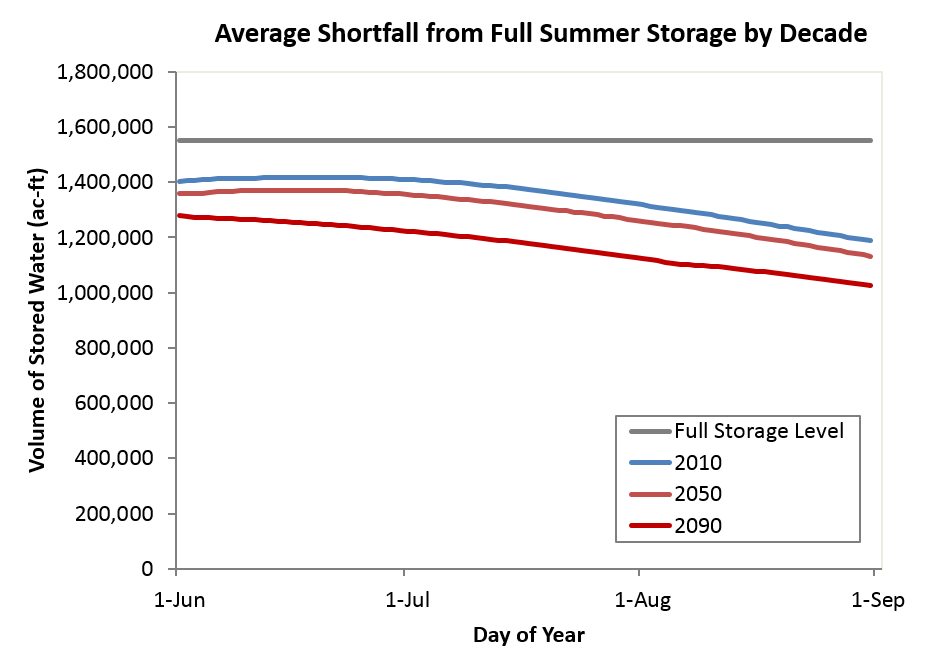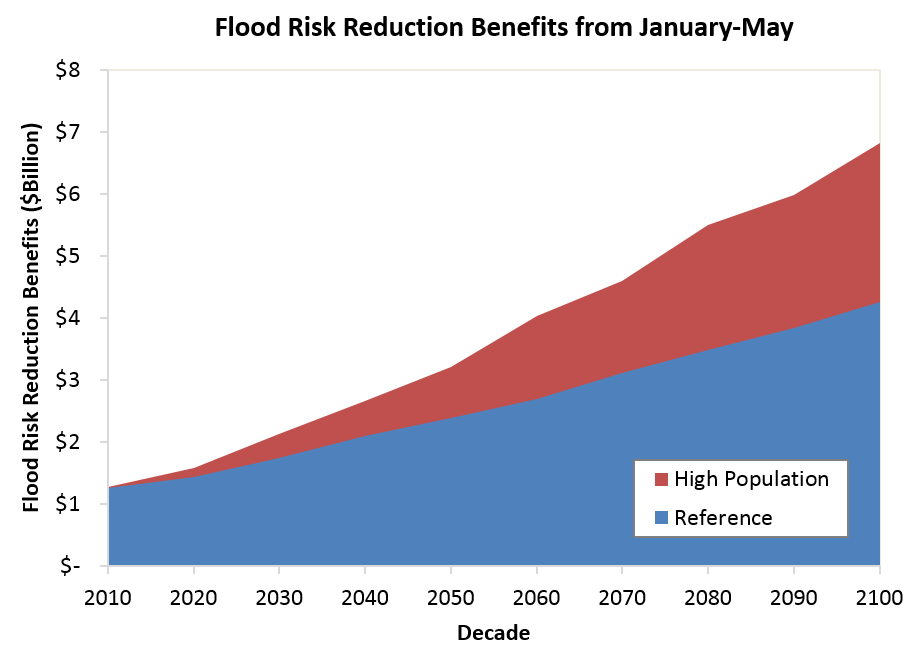Reservoir Economics
Together the 13 federal reservoirs in the Willamette River Basin help to mitigate water scarcity. Although the reservoirs were primarily built for flood control, they also provide a large capacity – a combined 1.6 million acre-feet – to store water from abundant winter and spring streamflows for possible use during the summer when natural flows are low. While flood risk reduction remains the priority use of these reservoirs, stored water uses – including reservoir recreation and increasing downstream flows for endangered species, irrigated agriculture, and municipal uses – have become increasingly important. Because reservoir capacity cannot be used for flood control and water storage at the same time, these uses must be traded off during the transition from the wet to dry season.
Our modelling results indicate increasing shortfalls from full storage at the beginning of summer over the next century, particularly under warmer climate scenarios. Greater summer drawdowns are also more likely, as obligations to release water for downstream conservation flows or contracted stored water increasingly exceed natural inflow. Based on empirical evidence that fewer people visit these reservoirs for recreation when water levels are reduced, losses in annual recreational benefits are expected to increase from an average of $5 million over the first half of this century to more than $12 million toward the end of the century. These estimated losses represent approximately 5% of total estimated reservoir recreational benefits each summer. Recreational losses should, however, be considered relative to the estimated value of flood risk reduction. We estimate current flood control benefits at more than a billion dollars annually and expect these benefits to triple by 2100 with economic growth and urban expansion.
Reservoir Economics Methods in Brief
We estimated the value of stored water for recreation at the Willamette Basin federal reservoirs using monthly visitor count data obtained from the US Army Corp of Engineers (USACE) for the years 2001-2011 (period available at time of analysis), and an expected average willingness-to-pay per visitor day (Loomis, 2005). Lowered water levels can impact recreational use in various ways, including loss of boat ramp access and compromised aesthetics such as ‘bathtub rings.' Estimated losses in recreational benefits were based on WW2100 projected shortfalls in summer storage, and empirical evidence that fewer people visit the reservoirs when water levels are reduced (Moore, 2015).
We then estimated the value of reservoir capacity for flood risk reduction based on WW2100 projected land use within the Willamette River floodplain, the probability of flood events, and expected flood inundation. The extent of the floodplain was delineated according to the SLICES data layer developed by the Pacific Northwest Ecosystem Research Consortium (Hulse et al., 2002). We used a ‘bathtub’ model along with high-resolution topographic information (LiDAR) to estimate inundation associated with flood stage. Flood frequency and timing was assessed using the stream gauge record at Salem. Expected flood damages and the related value of reservoir capacity for flood risk reduction were estimated by integrating the spatially explicit estimates of structural value in the Willamette River floodplain, the modeled flood inundation, and assessed flood frequency distributions (Moore, 2015).
Select Findings from Reservoir Economics Analysis
The federal reservoirs in the Willamette River Basin serve multiple purposes, including flood risk reduction, reservoir recreation, and downstream flow augmentation. At certain times of the year, however, these uses compete with one another, and the value that society places on these competing uses should be considered in management decisions for water allocation. This section describes the expected changes in value for reservoir recreation and flood risk reduction over the next century.
Reservoir Recreation Benefits
-
Our modeling results indicate increasing shortfalls from full storage at the beginning of summer over time, particularly under warmer climate scenarios, as well as greater summer drawdowns as obligations to release water downstream for conservation flows or contracted stored water are increasingly unmet by natural inflow (Fig. 1).
-
Lost recreational benefits resulting from lowered summer (June-August) water levels are estimated to increase from an average of $5 million per year over most of this century to more than $12 million toward the end of the century under the Reference Case scenario (Fig. 2). Under the warmest climate scenario, average annual losses increase to almost $13.5 million during the last two decades of the century (Fig. 2).

Figure 1. Average shortfall from full summer storage by decade for the High Change Climate scenario.

Figure 2. Reduction in recreational benefits due to reservoir drawdown.
Flood Risk Reduction Benefits
- Current benefits from flood risk reduction are estimated at more than a billion dollars annually (Fig. 3).
- These benefits are expected to triple by 2100 under the Reference Case scenario, while under the High Population scenario, the projected benefits increase more than five times (Fig. 3).

Figure 3. Estimated flood risk reduction benefits from January through May under the Reference Case and High Population scenarios.
Conclusions
Losses in recreational benefits, associated with lowered summer reservoir water levels, are expected to increase from an average of $5 million per year over the first half of this century to more than $12 million by the end of the century. However, since the reservoirs are managed for both flood control and stored water uses, these projected recreational losses should be tempered against the estimated value of flood risk reduction. We estimate current flood control benefits at more than a billion dollars annually and expect these benefits to triple by 2100 with economic growth and urban expansion. Thus, there is a strong economic rationale to keep reservoir fill low as long as flood risk is high at the beginning of each calendar year, before beginning to fill for storage.
Related Links & Publications
-
Moore, K.M. (2015, May 5). Optimizing reservoir operations to adapt to climate and social change in the Willamette River Basin, Oregon, Recorded WW2100 Webinar. https://media.oregonstate.edu/media/t/0_qrvmvk9h
-
Moore, K.M. (2015). Optimizing reservoir operations to adapt to 21st century expectations of climate and social change in the Willamette River Basin, Oregon (Doctoral dissertation). Oregon State University, Corvallis, Ore. http://hdl.handle.net/1957/56208
Contributors to WW2100 Reservoir Economics Analysis
- Kathleen Moore, OSU Geography (completed PhD 2015; now a post-doctoral researcher, OSU Applied Economics)
- William Jaeger, OSU Applied Economics
References
Hulse, D., S. Gregory, and J. P. Baker (2002). Willamette River Basin Planning Atlas: Trajectories of Environmental and Ecological Change. Oregon State University Press.
Loomis, J. B. (2005). Updated outdoor recreation use values on national forests and other public lands. US Department of Agriculture, Forest Service, Pacific Northwest Research Station.
Moore, K.M. (2015). Optimizing reservoir operations to adapt to 21st century expectations of climate and social change in the Willamette River Basin, Oregon (Doctoral dissertation). Oregon State University, Corvallis, Ore. http://hdl.handle.net/1957/56208
Web page authors: K. Moore, W. Jaeger
Last updated: September 2016